|
Related FAQs:
Turtles, Turtles 2, Sliders, Turtle
Identification, Turtle
Behavior, Turtle
Compatibility, Turtle
Selection, Turtle Systems,
Turtle Systems 2, Turtle Feeding, Turtle Disease, Turtle Disease 2, Turtle Disease 3, Turtle Reproduction, & by Species:
Musk/Mud Turtles, Other
Sliders/Emydids (Pond, Painted...), Softshells, Snapping Turtles, Mata Matas, Tortoises, & FAQs on Red Ear Sliders:
Sliders, Sliders 2, Red Eared
Slider Identification, RES
Behavior, RES Compatibility,
RES Selection, RES Systems, RES
Feeding, RES Disease, RES Disease/Health 2, RES Reproduction, & Other Reptiles, Amphibians,
Related
Articles: Red Eared Slider
Care by Darrel Barton,
So your turtle has the Flu?
Recognising and treating respiratory infections in pet
turtles by Neale Monks,
Freshwater Livestock,
Turtle Stocking &
Compatibility
Part 2
To: Part 1 , Part 3
|
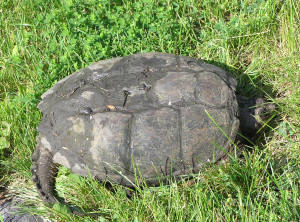
|
| by Sue Garrett |
|
Can RES be companions for single
painted turtle? 6/13/08
(Original heading: Lonely painted
turtle 6/13/08)
Hello, my name is Russell.
<Hiya Russell, I'm Darrel!>
I have a very simple but kind of stupid question.
<Hmmmm Contrary to popular opinion, there ARE such things as stupid
questions ... so let's see what happens next.>
Let me give you the facts first. I have three red eared sliders and I
am wanting to add a painted turtle to the pond, which is about 500
gallons . My question is will the painted turtle be lonely since there
is no other painted turtles in the pond with him, or will the sliders
keep him company?
<Russell, that is NOT a stupid question. In fact, that question is
the OPPOSITE of a stupid question and here's why: First, admitting
that you don't know something is a sign of education and
intelligence. The more someone learns, the more they realize that there
is always something new to learn. Second and most important to your
friends here at Wet Web Media ... is that you asked a question about
compatibility and the ultimate happiness of a pet in your care BEFORE
you purchased it and not AFTER. That's not only intelligent, but
compassionate as well. Third, nature is filled with species that get
along with themselves but not similar species, so it's a valid
question just on it's face. Give yourself a big pat on the back
from all of us here that all too often have to solve problems that were
created when no one asked a question first!!!!!!>
<Ahem>
<Now the good news! Sliders, Cooters, Painteds, Chicken Turtles, Map
Turtles, Red Bellies, Yellow Bellies and the like ... almost all the
Chrysemys, Pseudemys, Graptemys -- get along just fine. The Graptemys
(Map Turtles) need somewhat more attention to water quality and some of
the South American and Mexican sliders can be a bit snappy ... but that
aside and assuming similar sizes .... a Painted Turtle (Chrysemys picta
for example) will get along well with your sliders and be a part of the
happy family in your pond. Thanks for the intelligent question and the
great timing, Russell!>
<Darrel>
Turtles and koi mixed
07/18/07
Hello, Crew,
I have a few questions. Will a 5-year old female Eastern Painted turtle
eat koi that are larger than her? And will she leave an unfenced pond?
What about a 3-year old male? Thanks, Joe
<Hello Joe! Chrysemys picta picta is one of the nicest North
American freshwater turtles (what we call "terrapins" in
England, bizarrely enough after a Native American name for these
animals apparently not used by most North Americans!). In fact, this
was the second species I ever kept, and good fun it was too. Lived for
many years before being passed on to a zoo when I went to college.
Anyway, in common with other species in the genus, these animals are
primarily herbivorous, which is why their optimal diet in captivity is
one based on green foods. Juveniles will eat small fish as well as
insect larvae, but the adults are too slow and clumsy to catch fish,
though they certainly eat carrion. The problem is that in a pond the
odds are biased towards the turtle because it is more difficult for the
fish to swim away to safety. Feral red-ear terrapins have been reported
eating ducklings in London ponds, apparently being released into the
ponds by irresponsible owners bored with these large and somewhat
difficult pets. So while you might be lucky mixing koi and turtles, and
it's certainly be done, there are no guarantees at all. As for your
turtles upping-sticks and moving out: yes, very likely. Even if they
don't get out, there's nothing to stop predators like mink or
cats getting in, so this is something to consider carefully. Cheers,
Neale>
Mixing RES with Western Painted Turtles
7/27/06
(Original heading: Is my red eared slider
lonely ... Nope . Is your English bunk? Yep
7/27/06)
I had two red eared sliders, we got
them when they were little and they been together for about 4 years,
recently my other turtle wondered
<And wandered?>
off when she/he was in the yard and I haven't been able
to find it, I need to no
<Doctor?>
if it would be a good idea to get another slider because my
other turtle is not eating like he use to and he spends most
of his time in the corner of his tank. Would a
Western Painted turtle and a Red Eared slider turtle get
along in the same tank
<Mmm, about as well as a conspecific>
and if so if one is bigger or smaller then the other would
that be a problem.
<... about the same size is a good match. Please read here:
http://wetwebmedia.com/FWSubWebIndex/rescompfaqs.htm
and the linked files above.>
BobF>
Putting quarter size painted turtles with 3-4
red eared sliders 3/22/06
(Original heading: Poor Painted
Turtles - 03/22/06)
I have 2 red eared sliders that I've been
raising for about a year now and their doing awesome but now my sister
brought to me her 2 painted turtles she got this summer and they have
not grown at all! Theyre probably the size of a quarter still. She
never had a light or warm water or anything for them and now I have to
take care of them. I have no clue what to do with them and I feel bad
for them! All I have right now is one cage, so I put them in with my
red eared sliders. They're probably 3-4 inches and their a male and
female but I don't think their even one yet? Can they
reproduce?
< Probably not until next year.>
Is it okay for the baby painted turtles to be in the tank with
them?
< No, red eared sliders are very aggressive turtles and will hog all
the food and intimidate the smaller turtles to the point to they will
not eat.>
What should I do to help them grow?
< Start treating them like you RES's when they were small and
give them the TLC they deserve.>
When I pick them up I can actually feel their legs moving through the
center of their shell on the bottom in the center. I think their not in
good shape? What can I do? Help me please!
< Start by giving them their own tank. Set up a basking site that
gets at least 85 to 90 F. Start to give them ZooMed Aquatic Turtle food
for hatchlings along with some small washed earthworms. Basking and
proper diet with start to harden the shell and get them back on
track.-Chuck>
Mixing same size RES with Painted turtle
11/6/05
(Original heading: Mixing Turtles at the
Turtle Mixer 11/6/05
Hello, I have 4 red eared sliders and 3 of them
are being adopted. I wanted to know if I could put the red eared slider
that is left with my painted turtle. They are around the same size, but
I don't want either to get hurt. Please let me know. They will have
a 75 gallon tank.
< As long as they are all the same size and you spread the food out
all over the tank at feeding time they should be OK. Larger turtles get
quite temperamental. The larger the turtles the more feisty they
become.-Chuck>
Mixing Painted turtles with Snapping
turtles 9/7/05
(Original heading: Mixing Turtles
9/7/05)
I have a smaller painted turtle and I was just
given a baby snapper. For now I understand my painted is safe but in
the future would it be ok if the shared a tank? thank you Alex D
< I would not recommend ever putting these two turtles together.
Snapper gets too big and much too mean.-Chuck>
Suitable tank mates for new turtle
enclosure
(Original heading: Turtle
Enclosure.)
Dear WWM Crew,
I'm hoping that you could help me with some information on Eastern
Painted Turtles and a suitable enclosure for them. I understand that
this site is for fish related topics, but the categories are more
diverse here and I'm sure that you could point me in the right
direction.
<I am sure we can be of assistance. I actually have two Yellow
Bellied Sliders (pretty similar) that are native to Florida. They
summer out in my 1500 gallon pond, but I have to bring them indoors
once the water temperature hits 60*F. They are stinky if you do not
clean their tank often and filter it hard.>
I own an aquarium maintenance business in Southern N.H.
<I own one in Pittsburgh, PA.>
and usually deal with fish.
<Me too!>
I got a call from a construction company that is remodeling a
Veterinary hospital that had over the course of the summer, somehow
obtained some Painted Turtles that they rehabilitated. I'm not yet
sure what was wrong with the animals.
<Probably shell rot from poor captive care conditions.>
Currently the Turtles are being kept in a small aquarium awaiting a new
home. The Animal Hospital would like to make a large display tank for
the Turtles as a focal point for the waiting room area.
<Sounds like potential for a lovely indoor pond display.>
I am not very familiar with Turtles and would like to learn more about
the specific needs of these animals beyond the "Warm water, heat
lamp, rock to climb on." basics that I've been able to find.
From the limited information that I have found, it's apparent to me
that a short and wide enclosure is more desirable and that to feed them
properly is a water quality nightmare.
<Yes, I just upgraded my 75 gallon turtle tank to a trickle
filter.>
I was thinking of a short hex shape with about a third of the area
built into a land mass.
<Mine rarely get out of the water except to "sun", either
artificial or real. I use a small driftwood island in the pond and a
piece of driftwood tied in place with plastic cable ties
indoors.>
What recommendations might you have in regards to a land to water ratio
and Turtle "Furniture" I've also read that they do cut
themselves easily and that sharp objects are not suitable.
<I have not had any troubles with driftwood, but would also strongly
consider the indoor pond idea with a small area for them to climb out
of the water but not out of the enclosure.>
Lighting seems to be a very important issue as well, would Metal Halide
pendants be too much?
<Probably more than they need but they would appreciate it. I would
go for 6,500 K Iwasaki's, a 150 watt lamp. Otherwise, ceramic heat
lamps with fluorescent lamps for vitamin production.>
Would they not be of the right quality of light?
<The full spectrum lights more geared towards live plants would be
ok.>
What type of lighting would you recommend, I would really like to
recreate the environment as perfectly as I can.
<Either of the above options.>
From my reading I can't see any real consistency with the way
"Turtle People" keep their water quality.
<Massive and regular water changes>
Is pH and water hardness a concern for Turtles?
<I never measure either.>
I assume that the same rules would apply for biological filtration.
<Massive>
And what is a suitable water temperature. to keep the Turtles from
hibernating?
<Room temperature should be more than adequate with the lighting for
additional heat.>
Do you recommend chemical filtration?
<Activated carbon would help reduce odors.>
Many of the articles that I've read mentioned that no substrate is
best for the water portion of the enclosure, but I don't think that
the client will go for that, is there any preferable substrate for
Turtles?
<They will dig and generally make a mess of any gravel you put in
their. Strongly consider those black, hard plastic ponds. You should
get a good deal on them this late in the season. Two would be great.
One for them to swim in which drains down to a trickle filter, which
then pumps up to the second smaller pond run as a bog filter, which
lastly flows back to the turtle pond. Now that I think about the
MH's would be best for the indoor pond and bog filter idea.>
And, of course, I have to ask (as I'm sure the client will ask me)
if there are any suitable tank-mates to keep with Turtles maintenance
critters and/or display animals?
<They will try to eat most other things. You maybe able to house a
gold fish or two depending on the size of the turtles, size of the
goldfish, and size of the enclosure.>
Lastly, what type of skimmer do you recommend for this tank? Just
kidding, been a long night of research! Although, I would be interested
in any suggested reading.
<Take a look at Bob's article here
http://www.wetwebmedia.com/PondSubWebIndex/pdturtles+.htm the linked
FAQ file and the bibliography at the bottom.>
Thank you very much for your time and I appreciate your letting me
bombard you with all of these questions, that is if you're still
reading after all that! Again, thank you very much for your time.
Sincerely, Michael P. Gillespie
<Good luck! -Steven Pro>
|
YELLOW BELLIED
SLIDERS
Trachemys scripta
scripta
·
See Key Points at top of
this Topic Page for general information on turtle stocking &
compatibility.
|
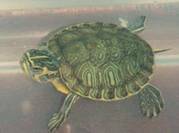
|
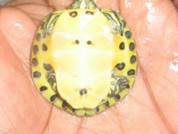
|
Temporarily mixing RES hatchlings with baby Yellow Bellied
Slider 3/31/07
(Original heading: Mixing Turtles
3/31/07)
Right now, we have 2 hatchling red eared sliders, and a baby yellow
bellied slider. Is it ok for them to be in the same tank for a couple
of days? Will the bigger yellow belly and the small red ear get into a
fight? And when I separate them, will the yellow belly be lonely or
depressed when the red ears are gone?
Thanks, Emily
< As long as the turtles are well fed they should be OK for a couple
of days. Turtles don't get depressed so the yellow belly will be
fine.-Chuck>
Compatibility with baby Red-Eared Slider?
9/11/06
(Original heading: Yellow Bellied Turtle
Questions 9/11/06)
Hello! Just discovered your site and have to say
it's brill! We have a yellow bellied slider called Tiny (not
appropriate any more!) He is about 14
months old and his shell is about 5.5 inches long. His diet is varied
frozen fish, bloodworm etc from the pet shop but I wondered if there
is
anything else we could give him. He is always begging for food and
seems healthy enough.
< As these turtles get older their diet changes from a meaty to a
more veggie diet. Offer some green spinach and kale. The fiber in the
veggies will keep them full longer.>
Also, should we clip his claws as they seem to have grown a lot even
though there are rocks for him to use in his tank?
< You probably have a male turtle. Their front claws are very long
compared to the female's claws. I would recommend that you leave
them alone.>
And also, one last question, could we add a baby slider to the same
tank or would he see it as an "invasion" of his space?
< The new turtle would be looked at as competition and would be
constantly harassed by the bigger turtle.>
The kids are begging us for another but the tank set up was expensive
so I really don't want to get a second tank! Keep up the excellent
work! Joanna, UK
< Thanks for your kind words.-Chuck>
Mixing Yellow Bellied Slider with hatchling
RES 6/15/06
Mixing Turtles 6/15/06
Hello Turtle Crew, Thank you in advance. We
inherited a YBS a couple years ago. His shell size now is approximately
5 inches long. We just purchased a hatchling RES (shell size 1.5
inches). The pet store owned said they would get along fine and the
large one wouldn't pick on the small one. I just read on your site
when a turtle wiggles his front legs in front of his face towards
another turtle, it is doing the mating dance. We are nervous. We
don't leave them in the tank together unless they are supervised
(which is a huge hassle). Would our older turtle try to mate with a
hatchling? Will he hurt the baby? I don't know the sex of either
turtle. Many thanks!
<I do not like to mix turtles. The YBS is probably a male with long
front claws and try to coax the new turtle into breeding. When the urge
to breed is over they will view each other as competition and will
fight over turf and food.-Chuck>
Matching male yellow-bellied slider with female
RES 5/15/06
(Original Heading: Run Away Turtle
5/15/06)
Hello, For a couple of months I have been letting
my 2 yellow-bellied turtles roam the back yard each day for about an
hour. I keep an eye on them and they usually go to the same places and
sleep. The male is much more active, but follows the same path, where
as the female finds a spot and digs in and sleeps. Well for the last
week the female has been burying herself under bushes making it
difficult to find her. And 2 days ago I lost her in the yard for good,
I was working in the garden and turned for about 10 minutes and we
can't find her anywhere. There's no access out of the back year
since its all cement wall, so I'm thinking she's nesting. Is it
that time of year?
< She may be looking for somewhere to lay her eggs.>
What I don't know is, is how long is the nesting process and will
she come back?
< If she has found a way out then she may not come back.>
I have 2 pools in the backyard, all natural, no chlorine, and I figured
she would head to the pool when done.
If she doesn't come back, I would like to get another female for
the male but I'm having a hard time locating a 3 year old female of
the same size.
Seems red sliders are more common. Is it okay to get a red slider
female to put with the male? Or is the male better off alone? I assume
they get attached to each other and he would like a companion, but I
have no idea if turtles are "family-oriented".. Appreciate
your help, Celeste
< Turtles really don't get along except to breed. The rest of
the time they are considered competition to each other. I would still
give it a few months before I gave up. Look at Kingsnake.com to find a
replacement turtle.-Chuck>
Compatibility with RES
(Original heading: TURTLE PALS)
Hi! I am putting my 7 year old Red-Eared Slider up
for adoption. Two people are interested in him. One has a 5 year old
Yellow-Bellied Turtle. The other has a 1 year old Red-Eared. Which
situation would be a better fit for my guy? Thank you
< Match him up with the yellow belled turtle. Turtles being kept
together should be close to the same
size.-Chuck>
Is it ok if I add another
turtle?
(Original heading: Turtle Habitat and
Pool)
<Hi, Mike D here>
I was wondering if I could bring my yellow bellied slider in the pool
which has chlorine in it.<If you're asking if you can take it
into your swimming pool with you, occasionally, for short periods
probably wouldn't do any harm, but long term exposure to higher
amounts of chlorine will eventually do eye damage and possibly cause
intestinal problems as well.> I was also wondering if it was ok to
have the fish rocks that are at the bottom of the fish tank in the cage
with the turtle and I have one last question will my turtle be ok
without having another turtle in the cage with it- can it be
alone??<Regular aquarium gravel would probably be alright, with sand
being a better choice, and as to keeping it alone, that often the best
way for the animal to stay the healthiest, as it can't fight with
other turtles over food.>
Thanks!!
please reply soon!!!! and how am I going to get your reply can you
email it back to me thanks so much !!!!
PS. How deep should the water be and what should I feed him?<The
depth of the water isn't overly important as long as there is a
good basking space where it can easily get out to sun itself.
You'll also need to invest in a good broad spectrum reptile light,
aimed at the basking area only> I found him in lake Travis-- is it
ok to feed him store bought food<Yes and no...there are some
commercial turtle foods that are satisfactory, with the old fashioned
dried insect type completely useless. Adding occasional pieces of lean
fish or chicken will help, and even better, try to dust it with a good
reptile calcium supplement.> and how big does the tank need to
be?<That depends upon the size of the turtle. A small juvenile can
be housed in a 2-5 gal. tank, with an adult animal needing an enclosure
large enough to allow plenty of movement.> Is it ok for
the tank to be bare with just gravel and water or does it need
something else? If using a regular aquarium, it will need a float or
piece of wood large enough to allow it to get completely out of the
water, thus the basking light. Keep in mind as well that reptiles need
to be kept warm, with a minimum of 72 degrees f and never allowed to
exceed the high 80's.> please please reply soooonnnn!!!!!!!!
thanks soo much <Michaela>
|
RED BELLIED
TURTLES
Genus:
Pseudemys
·
See Key Points at top of
this Topic Page for general information on turtle stocking &
compatibility.
|
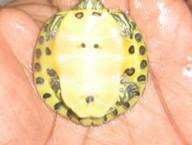
|
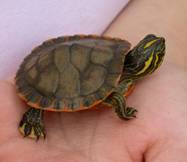
|
Red-bellied living with mollies and
guppies 12/5/07
(Original heading: Pudgy Turtle
problems12/5/07)
Clear Day
Hello.
<Hello to you , too!>
I have a red bellied Cooter that I had purchased in Feb. of 2006 for my
3 year old daughter. It was approx. 3 inches when we had gotten him and
he is now only 3.5 inches. He eats TetraMin turtle pellets and/or
TetraMin shrimp every to every other day. We keep him in our 29 gal.
fish tank with some mollies and guppies. All of the levels in the water
test out correctly and he has a turtle dock to bask outside of the
water under a UVA/UVB bulb. The water in the tank is filtered.
<The first comment I want to make here is that while turtles and
fish live in what appears to humans to be the same environment, in
reality they occupy very different niches in the aquatic world.
GENERALLY speaking, the conditions required for fish health are often
only marginal for turtles. In addition, while fish (especially healthy
fish) don't make up a high percentage of a turtle's diet, every
once in a while they just get lucky and suddenly a prized fish is
gone.>
Last week I noticed that the skin around his neck and legs seems
bubbled almost as if it is filled with air or something? I can't
seem to find anything about that other than swollen eyes which he does
not have. I didn't know if maybe he has some sort of shell growth
problem since he hasn't grown at all really and maybe he's
getting to chubby for his shell. If you could figure something out for
us I would greatly appreciate that.
<The questions to ask here are his behavior and activity. Is he
active? Any problems diving? Internal infections can cause gas pockets
that puff out and make a turtle extremely buoyant. This isn't
common without a slew of secondary symptoms, but I thought I'd
ask.>
<It's also possible -- just as you suspect -- that he is simply
obese and this is possibly due to a dietary imbalance or environmental
issues or both. First, see if you can obtain Koi Pellets at your local
fish store. I've used very high quality (and expensive) imported
brands and locally produced cheaper brands (such as Kay-Tee) with great
success. Failing this, Repto-Min food sticks are wonderful --
they're essentially identical to Koi pellets, just more expensive.
Make sure that his basking area gets to at least 83 degrees (f) and
preferably as high as 93 -- and that his water is no warmer than 73
(preferably 70). Either or both of these conditions can produce the
abnormalities you are describing -- a turtle that eats more than it is
metabolizing will have stunted growth while still appearing to be
fat.>
If you need pictures to better help in seeing his problem I would be
happy to provide them for you!
<Is his name Pete by any chance?>
<Please check out the following article and measure your care
against the recommendations and, by all means, write back with
pictures!>
<regards, Darrel>
< http://www.wetwebmedia.com/FWSubWebIndex/RESCareBarton.htm
>
Thank you very much!
Kimberly
|
MAP
TURTLES
Graptemys
geographica
·
See Key Points at top of
this Topic Page for general information on turtle stocking &
compatibility.
|
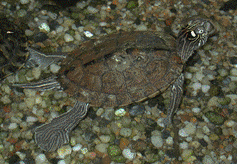
|
Baby Map Turtle and Juvenile RES in Same
Tank? 8/23/07
Hello?
<Hello?>
We have juvenile RES (about 1 ½ yrs) in a tank. We have purchased a
Mississippi Map turtle that is a baby and would like to put them in the
same tank. Do you think this would be a problem? The RES is about 5
inches from the top to bottom of shell and the Map turtle is about 2
inches.
Thanks!
Hope
<It is generally recommended that you don't mix species for a
number of reasons. One big difference between them is that the
Mississippi Map turtle (Graptemys sp.) is much more aquatic than the
Slider (Trachemys scripta elegans) and consequently much more sensitive
to poor water quality. Things that don't really bother Sliders,
such as small mounts of ammonia in the water, can prove fatal to Map
turtles by promoting bacterial infections. So you need to make sure the
water in its vivarium is very well filtered and changed regularly
(I'd suggest 100% weekly). Your other big problem is that the two
species have entirely different diets. Sliders are omnivores when young
and almost entirely herbivores when adult, so juveniles need 50% green
foods when young to 90% green foods when mature. Map turtles, on the
other hand, are specialist predators that feed on snails, crayfish etc.
Finally, there are differences in temperament. Map turtles are pretty
snappy, while Sliders are more laid back. If you have a really big
vivarium you might choose to give it a go anyway and see what happens,
but otherwise best keep them separated. Good luck, Neale>
Mixing Map and RES turtles
7/29/05
Mixing Turtles 7.29.05
Hi, I have recently found a Common Map Turtle and
I was wanting to keep it in the same tank as my Red Eared Slider. But
when I put it in the tank with the Slider, the Slider bit the Map
Turtle and when I separated them he kept trying to bite him again. I am
not sure of the gender of either turtle, but I would really like to
keep them together. Is the Slider being mean or was it just being
playful? And if I do have to get rid of one of them which would be the
best one to keep as a pet?
<Sounds like there are definitely going to be some problems with
aggression. I would keep them in separate tanks or release
the map turtle back to where you found it. Best Regards,
Gage>
Mixing smaller Map turtle with larger
RES
(Original heading: MATCHING
TURTLES)
Hi, I have a male red eared slider who's about
5-6". I recently got a young male Texas map who is about 2".
At first, I put the Texas map in with the RES in a 100g stock tank
filled with about 80g of water. The RES did not bite, but he was always
doing what looked like his mating dance right in the face of the Texas
map and also pushing him around constantly, but there was never
any biting. Never the less, I separated the two and put the Texas map
in a 20g long tank for now because I was worried about the behavior of
the RES, but I was wondering if there was a process I should go through
before adding him into the RES tank again? Is the Texas map just too
small to be added in with such a large RES? Should I start feeding the
RES outside of his tank in order to maybe lower potential aggression?
Or will it always be the case that I need to keep them separated?
Thanks for your time.
< It is always best to try to match up turtles according to size. I
would not try and keep the smaller turtle in with the larger turtle.
Eventually you will be away for a period of time and the bigger turtle
will try and eat the smaller turtle. If not eat then he will take bits
out of him and might bite off a limb. Even if the turtles are well fed
the larger one will continue to dominate the smaller turtle. If you
must put them in together then wait for the weekend when you can spend
some time watching them. Put them in together and then feed them.
Hopefully this will distract the larger turtle and he will leave the
smaller turtle alone. watch them carefully and decide if it is safe to
leave them alone.-Chuck>
|
SIDE/SNAKE NECK
TURTLES
Genus:
Chelodina
·
See Key Points at top of
this Topic Page for general information on turtle stocking &
compatibility.
|
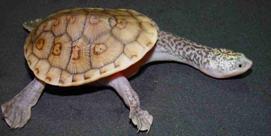
|
Mixing fish with snake neck
turtles 1/17/10
(Original heading: Re: decorating my
turtle tank 1/17/10)
hi Jamie here the guy with the snake neck turtles
<I remember. Darrel here -- the guy with the answers>
History :
I've had these turtles for a good 10 or so years and they've
"known" each other from young they are kept in a fairly large
tank. There was a time where the smaller had scratches of red ( not
drastically smaller but maybe small enough to make a significance )
and separating while feeding helped the scratches healed and that was
that , from then on separated while eating .
<Always a good thing to do with animals of different size and/or
disposition, the dominant animals always eat too much and the secondary
animals never get quite enough.>
I have noticed the smaller one has 3 claws on different
"feet" bent upwards I have the big one biting the little ones
foot. It doesn't exactly tear seeing as they don't bite just
try to swallow whole so it does look like any real harm just bent claws
*note this may have been done slowly overtime* and I have just realized
it but they only bite when there's food.
<Another reason to separate them at feeding time>
I dropped a calcium tablet they thinking it was food attacked and one
occasion each other and on other occasions just randomly bite at each
other I don't know if I should leave it be seeing as its not doing
real harm or should I add live fish to keep them occupied?
<I don't think fish would keep them occupied. More that likely
adding fish would just bring new parasites and new problems to your
system>
or more plants to let them "find" there way around. they
really seem to like the plants they like hiding and playing in and with
it should just put in heaps of plants and make like a water forest?
ever since I added plants in they seem to be happier the big one bites
at anything filter leaves etc but does no hard as there mouths are flat
and not beakish.
any help appreciated
<Changing the decorations is a standard trick for fish & reptile
keepers, Jamie. When you rearrange "home" they suddenly lose
their familiar territories and with that they lose a lot of the
confidence that allows them to be aggressive. Many times when adding a
new fish to an established aquarium, a keeper will rearrange the rocks
and plants so that the existing fish have enough to worry about and not
concentrate on the new guy. The same thing applies here. Also,
decorations that allow each turtle to get 'away' from the other
one where they can't see each other (called "Visual
Privacy") is known to be a good and healthy thing.>
<I think you ideas are good ones>
many thanks
<Yer welcome!>
|
LONG NECK
TURTLES
Eastern Long Neck Turtle (shown on
right)
·
See Key Points at top of this Topic Page for general
information on turtle stocking &
compatibility.
|
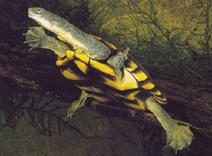
|
Mixing fish with Eastern Long Neck turtle
6/14/06
(Original heading: Three Turtles Not
Getting Along... good name for a bar...
6/14/06)
Hey guys, I am not too sure who to go for on help
with this as I have rung local pet shops and they aren't too sure
how to help me as they have not experienced this problem I have 3
turtles of 1 year of age (2 Eastern Long Neck and 1 Short Neck - I am
not too sure of the exact species name as I don't have my handbook
handy).
< I am not sure either.>
The problem is the short neck turtle is growing fast. The tank is more
than sufficient in size to accommodate the 3 turtles, the eastern long
necks are about 8 cm in diameter and the short neck is about 12 - 15
cm. The short neck has become quite aggressive and over the last two
weeks I have noticed well, I wouldn't say fighting but meal times
have become a bit aggressive. This has furthered to the short neck
attacking and biting the foot of one of the longnecks consistently
(this started 3 days ago) and I have noticed that it is still in good
health but it is staying on the turtle dock out of the water. I am sure
that it is more than them just playing and I am worried that the
longneck is going to end up hurt. Tomorrow I will be buying a heater
for my other spare tank and it has a filter and all, however, this
leads to one of my questions, am I able to put goldfish in with the
Longnecks while they are small and will not eat them? if need be I will
give them to the neighbours next door it is not an issue just I am
checking to see if they can be put in the same tank?)
<Turtles eat fish in nature. Usually they cannot catch them on their
own and end up eating the dead and sick ones. The turtles would
probably continually chase them until they finally caught one to eat.
Turtles are very messy and their waste would soon pollute a tank to the
point where fish would find it difficult to live. I would go without
the fish.>
I am sure that the long neck and the short neck are not getting on and
it is more than just playing, and I am sure the long neck is not going
into hibernation as it is moving around and quite awake (we have just
gone into winter here now) Thank you for your help Michael
< Turtles are not social animals. In nature and in your tank they
actually view each other as completion and will continue to harass each
other until they are separated. I often recommend only one turtle to a
tank.-Chuck>
|
REEVES
TURTLES
Chinemys
Reevesii
·
See Key Points at top of this Topic Page for general
information on turtle stocking &
compatibility.
|
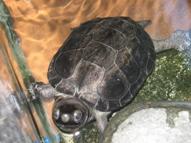
|
Reeves turtles/Golden thread turtles
paradise or turtle slum? 10/29/09
Hello
Crew
I have a question about setting up a turtle tank. I have never owned
turtles.
<Buy a book. Seriously. Turtles are fairly expensive and very
long-lived pets, so this is something you're going to be doing for
the next twenty years. An evening spent reading a book written by a
turtle-keeping expert will give you a fair idea of what's involved
and whether it's a hobby that appeals. Am I trying to sound
discouraging? Only slightly: while I like turtles as much as the next
person, I have to admit they're bad pets for most people.>
I am sure you get many questions about that and hope that I am not
reiterating something that has been discussed. After several hours of
searching both your website and others I could not find any answers to
my questions or at least not enough to answer the full question.
<Fire away.>
I am acquiring a used tank that has in my mind become a turtle utopia
:D (haven't even got it home yet) and I was hoping for some
constructive criticism the tank is 4ft x 20in x 24in tall.
<That's about 100 US gallons, which is a reasonably good size,
particularly given the fairly small size of Reeves' Turtle
(Chinemys reevesii). Golden Thread Turtles (Ocadia sinensis) get much
bigger, but they should still fit in there comfortably. Provided you
used a really beefy filter to keep the water clear, you should be
fine.>
I had planned on making it 30% land and of course %70 water filling it
to 1/2 (12in) water with a partial sand bottom the rest bare and a
sand/ver..(can't remember the name, used for planting
aquariums)
<...vermiculite... floats in water...>
mix for the land mass with a acrylic/plastic stand with a gradual slant
for the land to sit on, with a waterfall.
<Would stick with plain vanilla smooth silica sand, just 1 cm or so;
easy to clean, chemically inert.>
I would plant it with ingestible plants (yes I know not beautiful for
long)
<Pointless... turtle food. At best, get epiphytic plants (e.g., Java
fern and Anubias) that are distasteful so should be left alone. Can be
removed and run under a cold tap to rinse of gunk. Rooted plants will
be eaten, damaged, uprooted, or otherwise clogged up with silt and
faeces and bits of reptile skin. Add floating plants (like Indian Fern)
that will be eaten but are cheap/easy to replace.>
that would have about 4 months to grow as the hatchling turtles would
be in a smaller tank till they began swimming quite well (would this
take closer to 6 months or a year?).
<Something like that.>
I would plant part of the land as well, also with nonpoisonous
plants.
<Again, approach with caution; the land should really be a flat
stone or something that absorbs heat, since this is where the turtles
warm up.>
Other half basking/nesting site. I was planning on introducing 4
turtles, 2 Reeves turtles (have read that they are aquatic on some
sites and semi-aquatic on others)
<Are more or less entirely aquatic when young living, in very
shallow water, becoming more and more terrestrial as adults, though
they still swim periodically and don't travel far from water.
Indeed, Chinemys reevesii shouldn't be kept in tanks with deep
water at all; if they can't stand up in the shallow end of the
water (usually on their back feet, with their noses poking out) then
the water is too deep.>
and 2 Golden thread turtles (aquatic). Hoping for a male and female of
each and hoping they would breed.
<Good luck!>
Ok now for the questions (sorry for the extended background); 1)
Although these are smaller turtles is there going to be enough room for
them?
<Should be okay, but that said, males of both species can be
aggressive and won't tolerate others of their gender in this
environment. Sexing juveniles is difficult, and having an expert look
over the prospective turtles before you buy them would be a good idea.
Whether males of different species would fight is difficult to say;
usually males of different species ignore each other, but there are no
guarantees.>
I don't want them to be crowded and I know that some people have
bigger ones in less but I want them to be happy.
2) If I had both would they inter-breed? I know both these turtles are
endangered or threatened in there natural habitat I do not want to
create some bizarre hybrid I would want them to stay true to
species.
<Unlikely to hybridise.>
3) Should I get the females a year or so before the males? As I am
under the impression they sexually mature later in life and this may
aggravate the males and possibly lead to some serious issues.
<Certainly a good idea. Also likely to minimise aggression, since
the males will be strangers and the females established in the
vivarium. On the other hand, if you add one male at one time, and
another male of the other species some time later, there could be
fighting.>
4) How long (I know not definite but approximate) till they are
sexually mature?
<Varies with species, but with Ocadia sinensis the males are mature
from 12 cm at minimum, females from 20 cm. For Chinemys reevesii,
sexual maturity is around the 10 cm mark.>
5) Can these species live harmoniously or am I just asking for
trouble?
<Reptiles generally are not social, and almost by definition keeping
multiple species and both sexes is asking for some degree of trouble.
While raising them together should solve some problems, there are no
guarantees.
The standard advice is usually to keep turtles as one species, one
specimen to a tank, except for breeding. Obviously not everyone does
this, and oftentimes mixing them works fine. Both these species are
fairly peaceful though.>
6) Would placing a removable basket below ground lvl in the nesting
site filled with the substrate work for removal to an incubator? or do
they need to be removed from how the mother lays them?
<Yes, a removable sand tray is fine.>
7) Do you know of any sites that give the specifics on breeding these
species?
<Start off at
http://www.chelonia.org/
and
http://redearslider.com/
Even if they don't have pages on these species breeding habits,
their associated forums and other resources should help.>
I have read that they are some of the most common turtles sold but I
have not been able to find ANY info on breeding them and have ran into
very few people who even know what they are. My LFS people just look at
me and blink lol even the GOOD LFS guys tell me they don't have any
idea what I am talking about. Reptile place also has no idea. The other
pet store is keeping box turtles in a 10G with a rock for basking that
barely fits one of the two and no other land.... Going to have to mail
order them.
Thank-you so much for your time sorry about the length or the message.
I have researched the basic care of turtles and these guys in
particular but I am getting different stories and not much specifics. I
want to make sure I set their tank up right and have what they need
BEFORE I get the little guys.
Sincerely KJ Cahoon
<Cheers, Neale.>
|
POND
TURTLES
Clemmys
marmorata
·
See Key Points at top of this Topic Page for general
information on turtle stocking & compatibility.
|
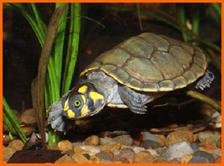
|
Mixing Pond Turtles with other aquatic
animals
(Original heading: Turtle
Buddies)
Are there any other aquatic animals that can
safely cohabitate with a larger turtle (in our case a pacific pond
turtle)?
<Not that I can think of off the top of my head, feeder goldfish
have been known to last a little while, but eventually get eaten, I
imagine a crawfish would make a nice snack, frogs or newts would be
lunch. You could try a very fast durable fish, something
that can put up with less than perfect water quality. I had
some Giant Danios spawn in one of my turtle tanks once, ended up eating
all the fry, but the adults survived with the turtle for a
while. A few years down the road I figured I'd try the
Giant Danios with the same type of turtle, they where all eaten within
a week. So, fast, durable, forgiving fish, with good cover,
and you may be able to pull it off, but I would not recommend it.
-Gage>
|
GOLDEN THREAD
TURTLES
Ocadia Sinensis
·
See Key Points at top of this Topic Page for general
information on turtle stocking &
compatibility.
|
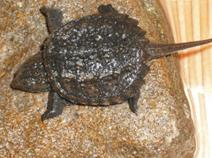
|
Reeves turtles/Golden thread turtles
paradise or turtle slum? 10/29/09
Hello
Crew
I have a question about setting up a turtle tank. I have never owned
turtles.
<Buy a book. Seriously. Turtles are fairly expensive and very
long-lived pets, so this is something you're going to be doing for
the next twenty years. An evening spent reading a book written by a
turtle-keeping expert will give you a fair idea of what's involved
and whether it's a hobby that appeals. Am I trying to sound
discouraging? Only slightly: while I like turtles as much as the next
person, I have to admit they're bad pets for most people.>
I am sure you get many questions about that and hope that I am not
reiterating something that has been discussed. After several hours of
searching both your website and others I could not find any answers to
my questions or at least not enough to answer the full question.
<Fire away.>
I am acquiring a used tank that has in my mind become a turtle utopia
:D (haven't even got it home yet) and I was hoping for some
constructive criticism the tank is 4ft x 20in x 24in tall.
<That's about 100 US gallons, which is a reasonably good size,
particularly given the fairly small size of Reeves' Turtle
(Chinemys reevesii). Golden Thread Turtles (Ocadia sinensis) get much
bigger, but they should still fit in there comfortably. Provided you
used a really beefy filter to keep the water clear, you should be
fine.>
I had planned on making it 30% land and of course %70 water filling it
to 1/2 (12in) water with a partial sand bottom the rest bare and a
sand/ver..(can't remember the name, used for planting
aquariums)
<...vermiculite... floats in water...>
mix for the land mass with a acrylic/plastic stand with a gradual slant
for the land to sit on, with a waterfall.
<Would stick with plain vanilla smooth silica sand, just 1 cm or so;
easy to clean, chemically inert.>
I would plant it with ingestible plants (yes I know not beautiful for
long)
<Pointless... turtle food. At best, get epiphytic plants (e.g., Java
fern and Anubias) that are distasteful so should be left alone. Can be
removed and run under a cold tap to rinse of gunk. Rooted plants will
be eaten, damaged, uprooted, or otherwise clogged up with silt and
faeces and bits of reptile skin. Add floating plants (like Indian Fern)
that will be eaten but are cheap/easy to replace.>
that would have about 4 months to grow as the hatchling turtles would
be in a smaller tank till they began swimming quite well (would this
take closer to 6 months or a year?).
<Something like that.>
I would plant part of the land as well, also with nonpoisonous
plants.
<Again, approach with caution; the land should really be a flat
stone or something that absorbs heat, since this is where the turtles
warm up.>
Other half basking/nesting site. I was planning on introducing 4
turtles, 2 Reeves turtles (have read that they are aquatic on some
sites and semi-aquatic on others)
<Are more or less entirely aquatic when young living, in very
shallow water, becoming more and more terrestrial as adults, though
they still swim periodically and don't travel far from water.
Indeed, Chinemys reevesii shouldn't be kept in tanks with deep
water at all; if they can't stand up in the shallow end of the
water (usually on their back feet, with their noses poking out) then
the water is too deep.>
and 2 Golden thread turtles (aquatic). Hoping for a male and female of
each and hoping they would breed.
<Good luck!>
Ok now for the questions (sorry for the extended background); 1)
Although these are smaller turtles is there going to be enough room for
them?
<Should be okay, but that said, males of both species can be
aggressive and won't tolerate others of their gender in this
environment. Sexing juveniles is difficult, and having an expert look
over the prospective turtles before you buy them would be a good idea.
Whether males of different species would fight is difficult to say;
usually males of different species ignore each other, but there are no
guarantees.>
I don't want them to be crowded and I know that some people have
bigger ones in less but I want them to be happy.
2) If I had both would they inter-breed? I know both these turtles are
endangered or threatened in there natural habitat I do not want to
create some bizarre hybrid I would want them to stay true to
species.
<Unlikely to hybridise.>
3) Should I get the females a year or so before the males? As I am
under the impression they sexually mature later in life and this may
aggravate the males and possibly lead to some serious issues.
<Certainly a good idea. Also likely to minimise aggression, since
the males will be strangers and the females established in the
vivarium. On the other hand, if you add one male at one time, and
another male of the other species some time later, there could be
fighting.>
4) How long (I know not definite but approximate) till they are
sexually mature?
<Varies with species, but with Ocadia sinensis the males are mature
from 12 cm at minimum, females from 20 cm. For Chinemys reevesii,
sexual maturity is around the 10 cm mark.>
5) Can these species live harmoniously or am I just asking for
trouble?
<Reptiles generally are not social, and almost by definition keeping
multiple species and both sexes is asking for some degree of trouble.
While raising them together should solve some problems, there are no
guarantees.
The standard advice is usually to keep turtles as one species, one
specimen to a tank, except for breeding. Obviously not everyone does
this, and oftentimes mixing them works fine. Both these species are
fairly peaceful though.>
6) Would placing a removable basket below ground lvl in the nesting
site filled with the substrate work for removal to an incubator? or do
they need to be removed from how the mother lays them?
<Yes, a removable sand tray is fine.>
7) Do you know of any sites that give the specifics on breeding these
species?
<Start off at
http://www.chelonia.org/
and
http://redearslider.com/
Even if they don't have pages on these species breeding habits,
their associated forums and other resources should help.>
I have read that they are some of the most common turtles sold but I
have not been able to find ANY info on breeding them and have ran into
very few people who even know what they are. My LFS people just look at
me and blink lol even the GOOD LFS guys tell me they don't have any
idea what I am talking about. Reptile place also has no idea. The other
pet store is keeping box turtles in a 10G with a rock for basking that
barely fits one of the two and no other land.... Going to have to mail
order them.
Thank-you so much for your time sorry about the length or the message.
I have researched the basic care of turtles and these guys in
particular but I am getting different stories and not much specifics. I
want to make sure I set their tank up right and have what they need
BEFORE I get the little guys.
Sincerely KJ Cahoon
<Cheers, Neale.>
|
SPECIES NOT
SPECIFIED
·
See Key Points at top of this Topic Page for general
information on turtle stocking &
compatibility.
|
|
Will my turtle get lonely in the pond should I
get a companion turtle? 7/6/08
(Original heading: Pond for
turtle... 7/6/08)
hi,
<Hiya Juanita -- Darrel here>
I'm planning to build a pond in my new home (when the house is done
so it will be in a couple of months). I've had a little turtle
that's about the size of my hand (not counting fingers) and the guy
that sold it to me said that it would get as big as a plate. At the
moment she's in a very very little aquarium and she doesn't fit
in it anymore (she does fit in it but can't move a lot). So
I've been looking around to see how this pond thing works because I
really don't know much about ponds. I've got lots of
questions.
1.) How big does the pond have to be?
<It doesn't have to be all that big -- the trade-off is that
that larger the body of water, the less it resists change (heating in
summer, cooling in winter) and the larger the pond, the less likely one
turtle will foul the water -- but then the filter needs to be bigger
and when it does need service the job is that much larger. I've
seen a single slider housed happily in a 67 gallon preformed plaster
pond.>
2.) Should I buy a pond or build one?
<Too many variables for here -- building a pond gives you many more
options but costs more and takes longer. Buying a preformed pond lets
you dig a hole and have a pond all in the same day>
3.) Do I put a fence around the pond so the turtle doesn't escape?
(the back yard is going to be fenced)
<YES! Turtles are remarkably good climbers. The fence should be
twice as tall as his shell is long, PLUS another 5 inches bent INWARDS
(like a flat lip) on the top.>
4.)Should I put fish in with the turtle?
<Not for the turtle's benefit, no. Many of us have put in
'feeder goldfish' at some point, only to have them grow to be
almost the size of small Koi and become pets themselves. The truth is
that turtles are more opportunistic and scavenger eaters and rarely
catch a healthy fish>
5.)Do I need a water fall? If yes how do I set one up?
<Not unless you like the look and the sound, but they are pretty and
they do help aerate the water. Give it some thought -- doesn't have
to be complicated, either -- if you BUILD a pond, you can find many
books at the local building supply store giving you all of the in's
& out's and if you decide to BUY a pond, most of those same
stores sell the kind where you can buy a small pond and have it drain
into a bigger one -- presto! instant waterfall>
6.)Do I need to put sand or rocks around the pond so the turtle can go
out of the water or can I put things in the water that stick out?
<Yes, this is important. Turtles are more comfortable climbing out
of the water on a rock or a log than they are climbing to shore. If you
BUILD a pond, put in a couple of shallow-sided bays for him to crawl
out. Preformed ponds are designed for water gardens and Koi and usually
have steep sides, but they make them with a shallow shelf-tray on one
side to hold plants -- you can place stones and large rocks there in
"ramps" so that he can climb out & bask on the rock or
easily make it to shore>
7.)How do you put a filter in?
8.)How do I choose a filter?
<Again, more many variables than we can discuss here. External
filters are a better bet for long term use because they require less
care, but in pond filters are less expensive and easier to clean -- the
major building supply chains that sell the preformed ponds sell a range
of low end pumps and filters that should be just fine for a turtle or
two in a pond>
9.)What kind of plants do I need?
<none, really. Turtles just tear them up>
10.)Can I keep the turtle out year round? (I live in Florida so the
cold weather is not a big deal)
<You can from a temperature standpoint. In fact, winter isn't
usually the problem -- it's summer. Remember when I said the larger
the pond, the more resistant it is? Well beside the fact that a larger
pond stays clearer longer, a larger pond stays cooler longer in summer
and warmer in winter. For example, a 20 gallon pond in the Florida sun
would get so hot so quickly that the turtle would suffer from over
heating if not in fact dying from it. Same turtle in a 1,000 pond
wouldn't even sense a temperature change. Assuming you will go
bigger than 10 and not 1,000 an important criteria is placing your pond
where it will get a good deal of shade in the hottest months.>
11.)Is the turtle going to get lonely? Should I buy another one?
<You can, they seem to get along just fine, but there is no
"need" to do that.
12.) How deep does the pond have to be?
<Again, deep water stays cooler in summer and warmer in winter ---
at least 18 inches at it's deepest point>
13.)What kind of plants can I put in or around the pond?
<on the OUTSIDE of the fence, around the perimeter, would be a great
place to plant some shrubs that would shade the afternoon sun (to the
west side of the pond) but nothing INSIDE the fence or he'll use it
to climb out.>
14.)Should I change the turtles feeding habits? Right now shes feeding
on "REPTILE PREMIUM STICKS" and once in a while romaine
lettuce or can she feed on plants in the pond.
<Repto-Min is great stuff. Koi Pellets from your local fish/pond
store is the SAME THING only a lot cheaper. Either one is fine &
no, don't change. I raise hatchlings to breeders on that same
food.>
15.)Are there any predators for her, like raccoons, snakes, or
squirrels? If yes what can I do to keep them out?
<Ah yes, a major down side to all outdoor life. They are all out
there and they will all try for her if they can. The only SURE way is
to make a fence with a tight fitting top and again this is a trade off
-- easy to do for a small pond, not possible for a large one. Beyond
that .. wide, deep water allows the turtle to rest on the bottom at
night, more or less out of sight and reach of the common
predators.>
16.)In what season or climate should I build the pond?
<In Florida? Any time it's not too hot for you to be out
there!>
<Good luck to you>
<Darrel>
|
Mixing Turtles Of Different Sizes
12/28/05
Dear WetWebMedia: Can you put baby turtles in with older older
turtles or will the older turtle hurt the baby turtle? Teresa
Day?
<Older larger turtles eventually pick on or intimidate smaller
younger turtles to the point that they will be afraid to eat.
When hungry older turtles will pick on younger turtles as
food.-Chuck>
Separate Turtles Of Different
Sizes 12/28/05
So I should separate the turtles? Teresa
< That would be best for the smaller
turtle.-Chuck>
|
|
Mixing new turtle with existing turtle and fish in 500 gallon
pond
(Original heading: Red- ear
slider)
My Uncle works for the water dept and last year brought a
turtle to me and asked to put it in my 500 gal pond. It appears
to be a male, long tail short claws. He just found another one in
the street and brought it over, I think it is a younger female,
long claws, shorter tail, will they get along? I have several koi
and about 6 smaller goldfish, my original turtle never bothered
them and I'm hoping they will all get along. Any problems
with this situation?
<Shouldn't be - though you may want to feed them from time
to time with prepared foods, or they may snack on your goldfish
if they can catch them (which isn't too likely). M.
Maddox>
Mixing new turtle with existing turtle and fish in 500
gallon pond
(Original heading: Red- ear
slider)
Thanks for the quick response, but I went this morning and
checked on everyone and my larger turtle has the little one
cornered and is biting at its head, feet, tail whatever he can
get a hold of...I got worried for the little ones safety and took
her out. Is this a mating thing or is he that aggressive??
<Hmm, no luck with them together I guess...if he doesn't
like her, I would wait until spring to re-introduce her and see
how it goes. Good luck! M. Maddox>
|
Each
turtle has unique personality; even same species
Turtle and fish Question
Hello there
Lovely site, easy to use and actually helpful and accurate, I just
wanted to add some of my experiences and a question or two (smile). I
have owned turtles since the 1980's, at the moment I own a 17yr old
and 1yr old RES
<Red Eared Slider>
and a 1yr old snapping turtle (common), all housed separately and if
there is one thing I have found is that each turtle, even same species,
in same tank, develop very different personalities, likes and dislikes.
Both of my RES are as opposite as night and day. I found that by giving
my turtle his basic needs, for a week or two, while he adapted, allowed
me to watch and learn, and set up a better, more personally suited
tank. My 17yr old, likes to eat
gravel and anything else that fits in his mouth, so he gets sand and
large rocks (had I not watched and learned, it could have been
disastrous)
<Very common, usually most small rocks will pass, but who wants to
take the risk, my turtles do not get gravel for that very reason, not
to mention cleaning Ugh.>
He is presently housed in a 90gallon open, sandy bottom tank, with some
(hardy) submerged (oxygenating) plants, and some very hardy fish
(they're my question). The oldest turtle also likes to keep one
goldfish, after a "feeding frenzy", so it fattens up I think
(smile), he also loves grapes, apples and cucumber. My other RES,
prefers dying fish only (and I swear expensive ones), and won't
touch a grape or apple. The older one is very outgoing and the other is
very quiet, leave me be attitude, yet both are
relatively docile. I've never performed a manicure on my boys (all
3 are males), I found rocks seem to keep it under control. My snapper
is nothing like what you read about and eats like a bird
<eats like a bird, or likes eating birds?>
, but is fat and healthy and active. Even though they are only
"turtles", they have very distinct personalities and
attitudes, if he/she is a cankerous turtle at a young age,
it always will be, they do not sweeten with age.
<Do they splash in the morning to wake you up to feed them?>
Turtles grow no matter what size tank you put them in, My 1yr old RES
and Snapper are housed in a 35 gallon (tall) and a 40gallon (long
wide), with lots of filtration, plants and driftwood. I personally
would not dream of starting a turtle in anything less than a 30gallon.
RES are active swimmers and the ones I have owned do more swimming than
basking. On the topic of plants and turtles, they really do not mix
well, so put your wallet away and
walk away from the $25.00 plant (smile). The only plants I have any
success with are the hardy submerged plants, like Hornwort, Anacharis,
Java Moss, and Elodea. Don't expect them to stay planted (if you do
plant them). They do just as well, just free floating around the tank.
Another good plant (although only seasonal (I'm in Canada here
:D> and needs lots of light) is
the water hyacinth and water lettuce (which help remove harmful
nutrients from the water - nitrates or nitrites), they are floating
plants, usually found in places with ponds, some local nurseries
etc....
Anyways that is some of my experiences, just please research before
buying a turtle, and not only online, go get a book, talk to other
turtle owners and have fun (smile).
My first question is I feed my turtles (and a small mouth bass I have,
as well as the unidentified fish) Rosy Reds and Feeder goldfish, I
always inspect or look at closely, each fish, before putting it in the
tanks (if it looks bad, it goes into quarantine), Anyway, one of my
Rosy Reds that I brought home 3 weeks ago (the Rosy Red is actually
grey and black) has
developed, I'd say in about the course of three days, a tumor on
its back, near the head, just off to one side has developed. The fish
seems unaffected, no other fish have it (has isolated already), upon
closer inspection of it, it is rock hard (like sticking your tongue in
your cheek, hard but skin moves), its the size of a pinhead. What in
the world is this?
There's no puss, no squishy stuff, no fungus looking
attachments.
<It is hard to tell without seeing it, if you can get a picture feel
free to send it along. It sounds like maybe a parasite or
tumor, but regardless, I think this is the least of the fishes worries
considering where he is going to end up.>
Question 2 - I have researched and researched and questioned people,
but no one seems to know what my fish are, the ones housed with the
older RES. Someone once told me they were (go by sound, not spelling)
Coreyopsis or Koryopses, no common name, when you type this into a
search engine and alt spellings, mostly you get info about a plant.
They are light golden colour, mouth brooders (my largest almost 9"
had what looked like Styrofoam balls in her mouth and then nothing, I
was told they were eggs and she was protecting them) When in dark, or
aggravated they get dark stripes like a tiger, and one going across,
they also have a dark dot on end tip of gill?? Do you know what these
are? I could email you a few pics of them, just let me know.
<Pics would be excellent, or we could talk about Coreopsis tinctoria
"A hardy, upright annual, native to the southern United
States">
Thanks, enjoy your pets, and sorry for being so long winded (smile)
<A fellow Chelonian lover, please write as often as you
like. Sorry I could not answer your questions more
specifically, but get us some pics and we will get to the bottom of
this. Thank you for sharing your experiences with us, our
turtle page could use few more FAQs. I agree with you
wholeheartedly, turtles need lots of water, lots of swimming room, and
heavy duty filtration, and that is just to reduce the maintenance to
weekly. These are filthy creatures, I mean that in
a loving way, that require constant
maintenance. Do you ever feed night crawlers? Turtles love
worms. Careful with that snapper, our fingers tend to look
like tasty treats. Best Regards, Gage>
Laura
|
SNAPPING
TURTLES
Common Snapping
Turtle
·
See Key Points at top of this Topic Page for general
information on turtle stocking &
compatibility.
·
Snapping turtles, in particular, should never be mixed with ANY
other animal or turtle species, including its own.
|
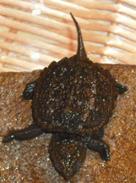
|
Mating and Compatibility with Red Eared
Sliders? 1/25/09
Snapping turtle mating & comp.
1/25/09
Dear Crew,
<Hiya Sucari, Darrel here tonight>
I have a 2 year old 7 inch snapping turtle and, age unknown 5 inch Red
Eared Slider in a 50 gallon tank.
<Actually, what you have there is a tragedy just waiting to
happen.>
They lived in the same tank for about a year now with no problems they
get along great.
<Get along great? Tell jokes? Like the same movies? Enjoy lively
political debate without crossing the line?>
For about a month now I have noticed that they are trying to mate. I
was wondering if I should have any concerns?
<I sure would have concerns, Sucari. For one thing, these mixed
relationships rarely work out. What would the neighbors think? What
about the in-laws? And the kids? Red Eared Snappers? Snapping
Sliders??????
And the kids! Think of the kids!!!! How sad to have a clutch of babies
that swim into the pond to try to lay in wait to ambush a piece of
river grass or hyacinth?>
Thanks
<OK, seriously, Sucari. All kidding aside, most turtles are very
tolerant of dissimilar species. They don't compete for food, no
mates to speak of and no territorial issues that really matter. Neither
see each other as a threat. And I too have seen Sliders and Snappers
and Soft Shelled turtles all kept together in relative harmony ...
until that day when one of them is just GONE. Sliders are non specific
scavenging herbivores and Snappers are ambush predators with very short
tempers and an instinctive, vicious 'ambush' strike that pretty
much destroys what it touches.>
<This is not to say that all snappers are mean or evil, Sucari. My
snapper, Biff, is mild tempered and easy to handle and he puts up with
a LOT before he starts to show any signs of stress. But still, I never
EVER forget that he is a wild animal with a tiny brain.>
<My point ... if there is any chance it has escaped anyone so far
... is that everything will be just fine right up until JUST the moment
that the snapper attacks and kills the slider. Will it ever happen?
Maybe not.
But how will you feel if it does?>
<Please separate them as soon as possible>
<Regards, Darrel>
Will RES and Snapping Turtle get along
together? 4/30/07
(Original heading: Mixing Turtle Species
Together 04/30/07)
I have had an adolescent red eared slider for a
couple weeks now. Its shell is just about an inch an a half to 2 inches
round. Today I got a adolescent snapping turtle that is 3 1/2 to 4
inches long. I know that snapping turtles are nippy and have short
tempers but I was curious to know if they would get along together and
if they would be healthy together? Both seem to be healthy and I am not
sure of the sex of them thanks for the help Alex =)
< I would not recommend placing these two turtles together. The
snapping turtle is actually a poor choice as a pet. The risk of injury
to the other turtle and to yourself is too
great.-Chuck>
Mixing Painted turtles with Snapping
turtles 9/7/05
(Original heading: Mixing Turtles
9/7/05)
I have a smaller painted turtle and I was just
given a baby snapper. For now I understand my painted is safe but in
the future would it be ok if the shared a tank? thank you Alex D
< I would not recommend ever putting these two turtles together.
Snapper gets too big and much too mean.-Chuck>
Snapping turtle and red eared slider
compatibility
(Original heading: Turtle
Mixes)
Is it ok for a snapper turtle and a red eared
slider to be together in the same tank?
<Not a good idea, you would need a huge tank for the snapper, and
there is a good chance that your slider could get hurt. Best
Regards, Gage>
|
SOFTSHELL
TURTLES
Family:
Trionychidae
·
See Key Points at top of this Topic Page for general
information on turtle stocking &
compatibility.
|

|
Mixing Softshell turtle species
together
(Original heading: Florida Soft
Shelled care, and turtle sys. period
8/30/08)
Dear Crew
<Hiya Tina - Darrel here today>
I am going to do my best and keep this short...
<Let's see how you do>
A few weeks ago my boyfriend surprised me with two baby turtles from
the reptile show that he had gone to, 1 Florida Soft Shelled
<Trionyx ferox!! one of my all time favorite turtles>
and a Spiny Soft Shelled
<Trionyx spinifer - virtually identical care & needs in every
respect>
We are reptile people and have had many snakes and lizards over the
years, some of which we bred, so the turtles are a new venture for
us!
<Welcome to a bigger world, Tina. At the risk of hurting the
feelings of my 4 iguanas, turtles and tortoises are my favorite
reptiles. While not possessing the intelligence or personality of the
iguanids, chelonians are fun, active, personable and generally fun to
be around ... come to think of it .. that also describes my last
girlfriend. Hmmmm>
They are in a tank together right now and seem to be getting along just
fine.
<Soft shell turtles are not particularly social, Tina. In the wild,
they tend to live singly like the snappers, mud & musk turtles as
opposed to the Emydids (Sliders, cooters, etc). They can be housed
together and usually will get along fine as long as there is enough
room for them to get away from each other when they need to. Make sure
you feed them separately as well. Try to entice them each to a
different corner of the tank at feeding time so they don't even
APPEAR to have to compete for food.>
The tank air is at about 80 to 85 degrees normally and the water ranges
from 72 in the early morning (before the lights turn on) and 76 by time
the lights turn off for the night. They have been eating a pellet food
that he got from the breeder and occasional frozen brine shrimp (which
the Florida loves!)
<Not bad. I use a high quality Koi Pellet for all my aquatic turtles
and I "treat" them with an occasional earthworm (night
crawlers which your local tropical fish store should carry) Brine
shrimp are OK, but there is very little nutritional value and the
uneaten shrimp foul your water ... which is an important consideration.
Pellet food and one worm per week per turtle is more than enough. The
worms will keep in the fridge for about a week and then you can dump
the rest in your garden, which does wonders for the plants.>
I have a filter and I am attempting to grow vegetation in the tank
presently.
<Item #1 and Item # VERY important, Tina. Our soft shells require
MUCH higher water quality than almost any other kind of turtle.
We're talking almost tropical fish-tank water quality. Crystal
clear and charcoal filtered. Skin/shell infections are serious
conditions for the Trionyx and VERY difficult to treat... so keep it
clean>
<**********General Note to Turtle Keepers Everywhere********>
<Please, abandon ALL hope of having a mature biological filter
system for your turtles the way you do for your fish tanks. Chelonian
dietary needs, combined with a fairly primitive digestive system
(aquatic turtles, at least) provide such a high output of .. um ... raw
materials for the biofilter that it has virtually NO hope of catching
up and keeping pace. Change the water regularly, siphon the bottom
every time you change, add lots of activated charcoal to the filter and
change it regularly.
<Thanks for listening>
I noticed today that the Florida has a white tint to his shell and I am
growing concerned, Why would this happen and is it dangerous to him. I
would like to know what to do to fix this problem now so that I can
keep him for a long time to come. Please let me know if you have a clue
as to what it may be. It doesn't appear to be filmy, just
white-ish.
<Difficult to say Tina, for a number of reasons. First, fungal
infections down IN the skin (as opposed to on the surface) will appear
whitish yet not slimy. Second,. as T. ferox matures and loses that dark
shell with the beautiful orange band, one of the first things that
happens is that the shell starts to "fade" by looking
slightly whitish. My suggestion for the moment is that you attend to
the water quality issues and then make sure that the tank lighting
provides UVA and UVB and then see that he (both of them actually) get
plenty of natural sunlight. 15 to 20 minutes a day of direct sunlight.
Now that doesn't mean COOK them of course. Put them in a box with
side high enough that they can't climb and place that box where
sunlight can hit the bottom directly and then cover half the top so
that there is shade. Even if they choose the shade, the unfiltered
light that reflects around the inside on the box is still "direct
enough" to be beneficial.>
<Here are some tips on keeping the Trionyx family: they DO bask just
like the rest of the water turtles and they NEED the UV light, same as
the others. Being somewhat shy about it, they do it carefully and away
from eyes (often in the weeds, reeds or tall grasses) in the wild. As
they grow, they spend much of their time buried in the sand where they
only need stick out their long snorkel-like neck to breathe. Now this
is the part that people miss, when the water is shallow enough that
they can be UNDER the sand and still stick their heads out of the
water, a LOT of that hot Florida sunshine is reaching them.>
<This brings up another tip: In every instance where I keep soft
shelled turtles, I have shallow water with small grained sand as least
3 times deeper than their shell so that they can engage in this natural
behavior. Sometimes that can be as simple as a small clear plastic
shoebox filled with sand and set inside a bigger "normal"
aquarium atop some rocks so that it's 1 inch under the
surface.>
Sincerely,
Tina
<Check the water quality issues, Tina. Provide the daily sunshine
and write us back in 14 days -- Darrel>
Turtles, RES and Soft Shell incomp. 4/5/08
Would it be ok to stick a red eared slider and a soft shelled turtle in
the same tank?
LOVE AMANDA!!!!!!!
<In a word, No. These turtles have different needs and different
temperaments. Soft-shell Turtles get big (the Florida Soft Shell Turtle
for example has a shell length of 60 cm/24", and the Spiny Soft
Shell is only a bit smaller) and are very bad tempered. They bite at
everything, including their keepers and any animals unfortunate enough
to be placed in the same tank. They are not a suitable species for the
home, and if you haven't bought this animal yet, think very VERY
carefully before you do so, because you will likely regret it. Red-ear
Sliders are generally fairly easy going and don't get nearly so
big, so provided you have a heater, UV-B lamp, filter, lots of green
foods, and space for the 55 gallon aquarium adults require, are quite
easy to keep. If you don't have these things and don't want to
buy them, please don't bother with turtles at all. Cheers,
Neale.>
Re: Turtles... mixing species 4/15/08
thank
you for the info, we now have them in different tanks and the soft
shelled turtle is very interesting and likes to bury himself into the
sandy bottom.
<I love it when people don't write to say "thanks"
until they want more information... gives me a nice warm glow knowing
that good manners are still a part of the modern world.>
But recently the red-eared slider stays on the turtle dock and does not
swim and has not eaten in a few days is she sick or what should we do?
thanks
<First tell me about the vivarium and care. How are you supplying
UV-B light? What foods are you using for the 50% plant material portion
of its diet the Red Ear Slider needs? How are you filtering the water?
How much water are you changing per week? What temperature do you keep
the water at? The reason I'm asking these questions is that
virtually all problems with Red Ear Sliders come down to people not
providing UV-B, not feeding them a plant-based diet, not filtering the
water, and not changing the water regularly. If you aren't doing
ALL of these things properly, then your first "thing to do"
is fix them. Cheers, Neale.>
Re: Turtles, WWM, manners/normative beh.
4/15/08
Are you always an ass when people ask you for
information? Because your the one with the website so if you don't
like people writing to you with questions then maybe you shouldn't
have one. Oh yeah and by the way thanks for the info!
Amanda
<Hello Amanda. Good manners cost nothing. Simply because you're
getting a service doesn't mean your manners should be neglected.
When you get a drink at a bar, or pay at the checkout at a grocery
store, I'm sure someone as well mannered as yourself would always
use those magic words "thank you" at the end of each
transaction. When you're getting something for free, such as the
expert advice from volunteers like me trying to help you care for your
animals, then being polite is even more important. I enjoy helping out
here at WWM because most of the people who write are fun to communicate
with. Humour, good manners, and a shared interest in animal welfare are
the things that keep me coming back. Cheers, Neale.>
RES and softshell turtles not
compatible 4/5/09
(Original heading: Turtle question,
RES, Softshell incomp. 4/5/09)
Hi, I have a red eared slider and a Softshell
turtle together in an aquarium.
<Mmm, not compatible>
They've peacefully coexisted since I got them both as babies last
July, but for a couple of weeks now the slider has been taking bites
out of the softshell's shell!
<Yes>
A man at the petstore suggested I buy a bigger tank so I upgraded from
a 10 gal to a 29 gal,
<Still too small>
but the slider is still doing it! What should I do?
<These two need to be kept in separate systems>
Thanks so much for your help,
Brandi Davis
<Welcome Brandi. Bob Fenner>
|
NORTH AMERICAN BOX
TURTLES
Terrapene
·
See Key Points at top of this Topic Page for general
information on turtle stocking &
compatibility.
|
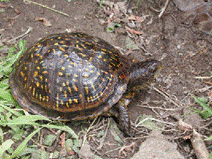
|
To: Part
1, Part 3
|
|

